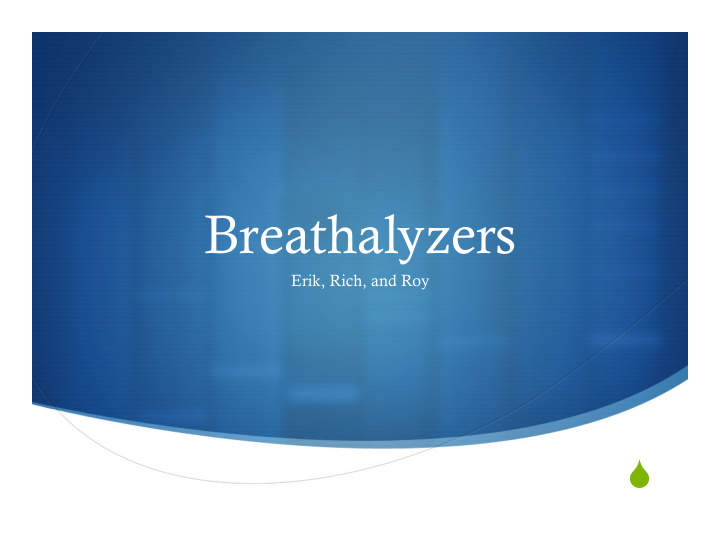



Breathalyzers Erik, Rich, and Roy S
Overview S How do breathalyzers work? S How “don’t” many current consumer breathalyzers work? S How can we augment existing technology using mobile devices?
Principles of Testing S Alcohol is absorbed from the mouth, throat, stomach and intestines into the bloodstream S As blood goes through the lungs, alcohol is exhaled through the alveolar air S 2,100:1 ratio of breath to blood alcohol S Example - 0.08 BAC means 0.08 grams of alcohol per 100ml of blood
Chemistry of Alcohol S Alcohol found in alcoholic beverages is ethyl alcohol (ethanol) S The OH (O – H) group makes it an alcohol S Strip hydrogen from the right carbon to get acetic acid S The ethanol à acetic acid oxidation produces 2 protons and 2 electrons
How the MQ-3 works The coil is heated up and 1) ceramic tube becomes semi- conductor Alcohol molecules meet the 2) electrode Ethanol burns into acetic acid, 3) protons and electrons created Current produced 4) proportional to the alcohol in the air
How the MQ-3 works S Current is measured by microcontroller, and BAC calculated S Frequent calibration is important!!! S Margin of error always present (temp and humidity)
An Evaluation of the Accuracy and Reliability of Popular Consumer Breathalyzers as compared to their Marketing Statements (2010) S
Consumer Breathalyzers S How are they regulated by the FDA? S How accurate are current consumer products? S How does this affect how they should be marketed?
The FDA & Breathalyzers S Public health & safety S 510(k) “screeners” S “FDA approved” or “FDA cleared”
How the FDA tests consumer breathalyzers S 20 tests at .000 BAC, .008 BAC, and .032 BAC
Testing protocol S Tested for range 0.08-0.10 S Individualized doses (Alcohol Administration Protocol from Rutgers University Center for Alcohol Studies) S Participant consumed 3 drinks 5 minutes apart over a 15 minute period
Testing protocol S Test Period 1 , 30 minutes post-dosing 3 readings each for 3 devices S S Test Period 2 , 45 - 60 minutes post-dosing 1 reading from each of the 5 devices S Blood sample S S Test Period 3 , 75 minutes – 105 minutes post dosing S “Each of the breathalyzers was tested 4 times by each of the 57 subjects producing a total of 228 test samples for each breathalyzer. One blood sample was also obtained from each of the 57 subjects.”
Accuracy and Reliability Findings S “Device readings ranged from 30% lower up to 65% higher than the test subjects mean BAC at the time of the testing.” S “In an average 180 pound male this margin of error is roughly equivalent to the difference between 1 drink per hour up to 2.5 drinks per hour.”
The marketing claims S Alcohawk Slim S “Operating on a single button, simply blow into the folding mouthpiece for an accurate BAC reading in seconds.” Sam’s Club website S “The AlcoHAWK Slim contains a software upgrade to allow the unit to track if an uneven alcohol concentration is detected in the sample. This cutting-edge technology provides another method of ensuring breath sample integrity.” Wal-Mart website
The marketing claims S BACtrack S50 S “Why guess your alcohol level when you can easily test with the professional and remarkably affordable BACtrack Select S50.” S “The BACtrack Select S50 uses law enforcement technology to provide trusted results” S “The BACtrack Select S50 is FDA 510(k) cleared for consumer use.” Costco Website
What this means for our project S Testing protocol S Additional information -> greater accuracy
The Kinetics of Ethanol Absorption and Elimination in Twins and Supplementary Repetitive Experiments in Singleton Subjects M. Kopun** and P. Propping European Journal of Clinical Pharmacology 1977 S
Testing what affects alcohol absorption S 40 twin pairs 25 Identical (avg 23 years old) S S Catagorized by S drinking habits S smoking habits S Had to been non-medicated for the past month S have functioning kidneys
Procedure 1. No food for dinner before 2. Arrive at institute at 8:00am 3. Eat 2 ham sandwiches (or not for later comparison) 4. Drink (1,2 ml per kg of body weight) of ethanol mixed in orange juice 5. Have blood samples drawn every 30 minutes for the next 4.5 hours
Data S For 4 cases S Solid line = Had breakfast S Dashed line = No breakfast
Results
Ethanol degradation rate formula S Avg results from the 80 people tested
Conclusion S To accurately predict blood alcohol level change over time we’ll need: S Body weight of person S Whether person drinks or smokes often S Whether food was eaten before alcohol S How much alcohol was drank S Previous BAC level
Recommend
More recommend